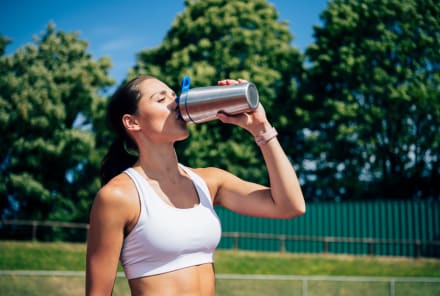Advertisement
Many Women Have Low Iron: Here's Why & What To Do About It


We won't sugarcoat it: Iron deficiency in women is alarmingly common. A study published in 2021 estimated that about 17% of menstruating women1 are deficient in iron. And a 2023 study published in JAMA found that up to 40% of girls between the ages of 12-212 had low levels of this essential mineral.
This is concerning because iron plays an integral role in making DNA, supporting energy production, and (most notably) shuttling oxygen around cells and tissues. Not having enough iron leads to nondescript symptoms like fatigue and lightheadedness—as well as cold hands and feet and pale skin—that are often dismissed as symptoms of menstruation. And at the end of the day, many more cases of iron deficiency likely go undetected or are only caught once the condition is severe.
So, how is this happening? Why has this condition become so prevalent and what can we do to correct it? For answers, we tapped the experts.
Why are women more prone to iron deficiency?
Women are more prone to iron deficiency because they’re prone to regular blood loss (aka menstruation). “Women with heavy menstrual bleeding, uterine fibroids, pregnancy, or blood loss during delivery may be particularly susceptible to iron deficiency and anemia,” says integrative medicine physician Bojana Jankovic Weatherly, M.D.
Iron is an integral part of the protein that’s in every single red blood cell in your body—hemoglobin. When you lose blood, you lose hemoglobin, and, therefore iron.
Think of iron as currency your body has to spend. First, it will pay off its immediate needs (like making red blood cells and so on), and only after those needs are met does it put iron into a savings account (aka a storage protein called ferritin). We want a high ferritin savings account so there’s enough iron to pull from when our iron needs increase—like during menstruation or pregnancy when there’s a huge increase in blood volume.
But blood loss drains those stores. So oftentimes, women are living paycheck to paycheck when it comes to iron.
Women require a fair amount of iron to keep their ferritin stores fully equipped. For example, it’s recommended that women get 18 milligrams of iron3 daily from food and supplements, whereas men just need 8 milligrams.
The current screening practices for iron deficiency are poor
Hemoglobin is the most common marker practitioners use to estimate iron status. Hemoglobin is included in standard yearly blood panels and can also be measured via a device that harmlessly clips onto a finger. But hemoglobin on its own is a better screener for anemia (low red blood cell count) than iron deficiency.
Oftentimes, women are living paycheck to paycheck when it comes to iron.
“In the first stage of iron deficiency, iron can be depleted, but we may not see anemia yet,” asserts Bojana. “Therefore, if bloodwork is checked, and iron markers aren’t specifically ordered, iron deficiency may be missed.”
This missed diagnosis can compromise someone’s well-being as well as the care they receive. According to Weatherly, not identifying the deficiency—or the root cause of it—can hurt a woman’s quality of life and leave chronic symptoms like fatigue unresolved.
What tests should be used to evaluate someone’s iron status?
There are several markers of iron status that can be measured through a blood test. These include serum ferritin, serum iron, total iron binding capacity, transferrin, and transferrin saturation.
“Ferritin is the most useful test,” says Weatherly. “If it’s low, it’s diagnostic of iron deficiency.”
Both Weatherly and registered dietitian and board-certified sports nutritionist Stevie Lyn Smith MS, RDN, CSSD, like to see their client’s ferritin levels between 40-200 ng/mL for optimal health.
That’s a big jump from the current iron deficiency anemia diagnosis cut-off of 15 ng/mL, although more research and physicians are pushing for levels of 30 ng/mL.
However, ferritin isn’t included in the blood tests typically run with yearly physicals, although many functional medicine practitioners will make sure to tack it on. Talk to your physician about getting your ferritin levels measured at your next blood draw, or try one of these convenient at-home options.
How can you raise your iron levels?
You can raise your iron levels through diet and supplementation. Animal proteins, and especially red meat, offer high amounts of bioavailable iron. Plants like spinach and soybeans also contain iron (it’s just not as well absorbed by the body). Women also often fall short of meeting their daily protein goals (hint: pretty much everyone should be getting at least 100 grams of protein daily). So upping your protein intake can also help boost your iron levels.
You should always pair iron-rich foods with a source of vitamin C, as it helps the body absorb even more.
Supplementation can also be beneficial for folks. “Formulations typically range between 15 and 65 milligrams of elemental iron (although there are options that are higher or lower than that),” says Weatherly. For example, some multivitamins may contain around 9 milligrams of iron in a serving and are an appropriate choice to help you reach optimal iron intake.
But you can overdo it on iron supplements. Too high of doses can actually impair the absorption of that iron4. And Smith is hesitant of any client that comes in taking over 40 milligrams.
Iron supplements are known for causing GI issues like constipation, diarrhea, nausea, and bloating. So it’s important to find a dose that delivers a beneficial amount of iron, without any side effects. Certain forms of iron are also more tolerated than others—we break down the best supplemental forms here.
What else could be impacting iron levels?
So what can you do if your iron levels just don’t budge? This is a common question Smith gets in her practice from highly active women with chronic sub-optimal iron levels.
“Some people are consuming enough iron, but can still show low levels of ferritin, the stored form of iron, or serum iron in their lab work,” says Smith. And this may be the fault of other nutrients.
“When other micronutrients needed to help transport iron where it needs to go are lacking, iron can get 'stuck' in the body—leading to fatigue, inflammation, and low iron levels,” Smith notes.
The takeaway
Iron deficiency is more common in women—especially menstruating women—because of regular blood loss. Make sure you regularly have your iron levels measured through blood tests (and ask your doctor about ferritin in particular), to evaluate and track your status over time. Supplementation, especially low doses, may help keep your iron levels where they should be. Whereas a higher dose is better to use short-term to correct a more pronounced deficiency.
If you’re not sure where to start on improving your iron levels, Smith recommends working with a provider who understands the full pathway of how iron is metabolized and can help you address the root cause of your low iron levels.
4 Sources
- https://www.who.int/data/gho/data/themes/topics/anaemia_in_women_and_children
- https://jamanetwork.com/journals/jama/fullarticle/2806540
- https://ods.od.nih.gov/factsheets/Iron-HealthProfessional/
- https://www.ncbi.nlm.nih.gov/pmc/articles/PMC7193469/#:~:text=In%20iron%2Ddepleted%20women%20without,is%20given%20on%20alternate%20days.
Watch Next
Enjoy some of our favorite clips from classes
Enjoy some of our favorite clips from classes
What Is Meditation?
Mindfulness/Spirituality | Light Watkins
Box Breathing
Mindfulness/Spirituality | Gwen Dittmar
What Breathwork Can Address
Mindfulness/Spirituality | Gwen Dittmar
The 8 Limbs of Yoga - What is Asana?
Yoga | Caley Alyssa
Two Standing Postures to Open Up Tight Hips
Yoga | Caley Alyssa
How Plants Can Optimize Athletic Performance
Nutrition | Rich Roll
What to Eat Before a Workout
Nutrition | Rich Roll
How Ayurveda Helps Us Navigate Modern Life
Nutrition | Sahara Rose
Messages About Love & Relationships
Love & Relationships | Esther Perel
Love Languages
Love & Relationships | Esther Perel
What Is Meditation?
Box Breathing
What Breathwork Can Address
The 8 Limbs of Yoga - What is Asana?
Two Standing Postures to Open Up Tight Hips
How Plants Can Optimize Athletic Performance
What to Eat Before a Workout
How Ayurveda Helps Us Navigate Modern Life
Messages About Love & Relationships
Love Languages
Advertisement

This Type Of Fat Is Vital For Women's Health — Are You Getting Enough?
Molly Knudsen, M.S., RDN

New Study Confirms The 3 Habits That Age Your Brain Faster
Molly Knudsen, M.S., RDN

This Type Of Fat Is Vital For Women's Health — Are You Getting Enough?
Molly Knudsen, M.S., RDN

New Study Confirms The 3 Habits That Age Your Brain Faster
Molly Knudsen, M.S., RDN













